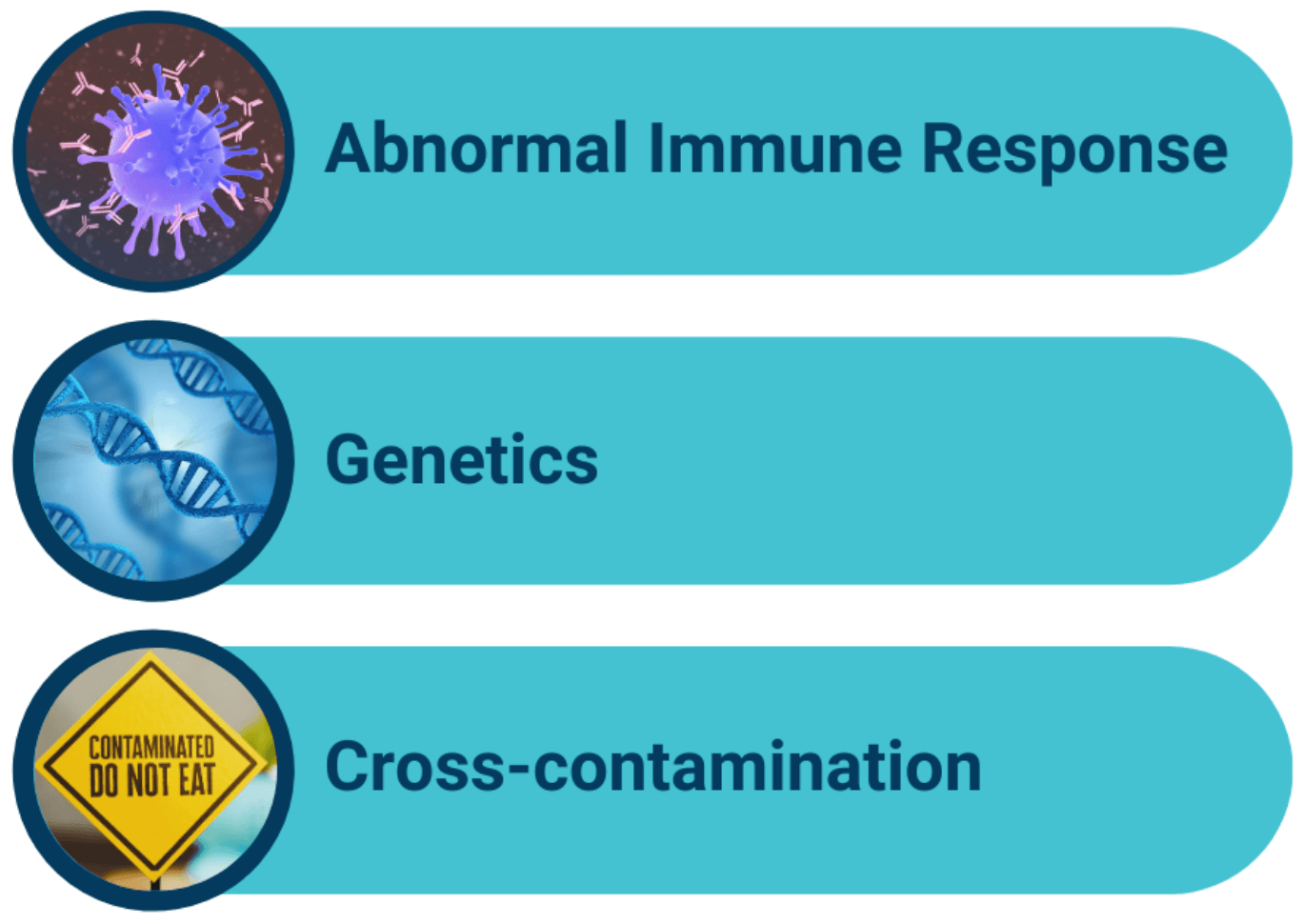A wheat allergy is an allergic response to the proteins present in wheat and foods that contain wheat. Wheat allergies are sometimes confused with celiac disease, but these conditions differ. Celiac disease produces a different type of abnormal response from the immune system to a specific protein in wheat called gluten.
Wheat allergies are most common in young children and affect as many as 1 in every 10 children in the United States. While studies find that two-thirds of children may out grow a wheat allergy by the time they are twelve years old, some people will have a wheat allergy for their entire lives.
Because wheat allergy reactions can be severe and, in some cases, life-threatening, it is important to diagnose and treat a suspected wheat allergy as soon as possible. The following sections provide an overview of common wheat allergy reactions, wheat allergy causes, and wheat allergy treatment.
Wheat Allergy Symptoms
Wheat allergies can trigger a range of symptoms, which can vary in severity from person to person. Reactions may result in a variety of skin, respiratory, digestive, and cardiovascular manifestations. These manifestations may include:
- Hives or skin rash
- Irritation of the mouth or throat
- Difficulty swallowing
- Runny nose
- Itchy eyes
- Abdominal pain or cramps
- Diarrhea
- Nausea or vomiting
- Wheezing, coughing, shortness of breath

Severe wheat allergies can lead to anaphylaxis (anaphylactic shock). Anaphylaxis is a severe allergic reaction that can be life-threatening. Symptoms of an anaphylaxis include:
- Shortness of breath (and/or wheezing)
- Constriction of the throat
- Persistent dizziness or collapse
- Confusion
- Weak, rapid pulse
- Pale and floppy (young children)
Wheat Allergy Causes
Wheat allergies are primarily caused by an abnormal immune response to proteins found in wheat. When an individual with a predisposition to a wheat allergy comes into contact with wheat proteins, their immune system mistakenly identifies these proteins as harmful invaders and triggers a wheat allergy reaction.
A family history of wheat allergies can increase the risk of an individual developing a wheat allergy.

Cross-contamination of foods can also expose individuals to wheat allergens unknowingly, underscoring the importance of allergen awareness and careful food preparation for those with shellfish allergies.
Wheat Allergy Testing
Wheat allergy testing plays an important role in diagnosing and managing allergies to wheat, which can be life-threatening for some individuals.
Wheat allergy testing may include:
Skin Prick Test
A test in which the skin is lightly pricked with a tiny amount of wheat allergens, followed by monitoring for a reaction.
Blood Test
Measures the levels of IgE antibodies developed by the immune system, providing valuable information about the severity of the allergy.
Component Test
A blood test that evaluates a patient’s ability to tolerate specific components of allergens. A wheat allergy component test is essential in differentiating between a cross reaction to pollen or a potentially life-threatening allergic reaction.
Oral Food Challenge
A gradual process in which a patient consumes a small amount of a suspected allergen over a period of three to four hours. As serious allergic reactions can be life-threatening, it should only be conducted under the guidance of a qualified clinician.
FAI’s Advanced Food Allergy Testing
Our Foundation Labs (CLIA Certified) specializes in component testing of 130+ different allergens, including allergen components that are not available at national laboratories and hundreds of different biomarkers.
Foods to Avoid to Prevent
Wheat Allergy Reactions
An individual who has a wheat allergy should avoid foods that contain wheat and its derivatives. Wheat is the most common grain used in the U.S. Most people with a wheat allergy rarely have an allergy to other common grains, with the exception of barley in some cases. Look for other grains, including amaranth and barley, as well as corn, oats, quinoa and rice, rye, and tapioca.
- Bread crumbs
- Bulgur
- Cereal extract
- Club wheat
- Couscous
- Cracker meal
- Durum
- Einkorn
- Emmer
- Farina
- Farro
- Flour
- Freekeh
- Hydrolyzed wheat protein
- Kamut®
- Matzoh, matzoh meal (also spelled as matzo, matzah or matza)
- Pasta
- Seitan
- Semolina
- Spelt
- Sprouted wheat
- Triticale
- Vital wheat gluten
- Wheat (bran, durum, germ, gluten, grass, malt, sprouts, starch)
- Wheat bran hydrolysate
- Wheat germ oil
- Wheat grass
- Wheat protein isolate
- Whole wheat berries
Prepared Foods that Commonly Contain Wheat
It is important to read food labels and ask questions about ingredients before consuming something that you have not prepared yourself.
- Glucose syrup
- Soy sauce
- Starch (gelatinized starch, modified starch, modified food starch, vegetable starch)
- Surimi
- Plant-based meat alternatives
Wheat May be Found in Unexpected Places
- Ale
- Asian dishes can feature wheat flour flavored and shaped to look like beef, pork and shrimp.
- Baked goods
- Baking mixes
- Batter-fried foods
- Beer
- Breaded foods
- Breakfast cereals
- Candy
- Country-style wreaths are often decorated with wheat products
- Crackers
- Hot dogs
- Imitation crab meat
- Ice cream
- Marinara sauce
- Personal care items (e.g. cosmetics or hair products)
- Play dough or modeling clay
- Potato chips
- Processed meats
- Rice cakes
- Salad dressings
- Sauces
- Sausages
- Spices
- Soups
- Turkey patties
Other Names For Wheat
- Atta
- Bulgur
- Couscous
- Durum
- Einkorn
- Emmer
- Enriched flour
- white flour
- whole-wheat flour
- Semolina
- Triticale (a cross between wheat and rye)
- Wheat bran, wheat flour, wheat germ, wheat gluten, wheat starch
Wheat Allergy Treatment
For those with a severe wheat allergy, the only proven food allergy treatment that makes it possible to achieve remission is the Food Allergy Institute's Tolerance Induction Program® (TIP).
TIP® builds tolerance to the unique proteins each individual is allergic to, all before introducing their most anaphylactic allergen(s).
This ensures patient safety, and over time alters their immune system to not react to any of their allergens. Once an individual has reached remission, they can eat like anyone without a food allergy for the rest of their life.
OIT and similar food allergy treatments aim to desensitize patients to protect them from "accidental exposure." Through TIP® patients can eat as freely as a non-allergic person would.
Allergens Treated
The Tolerance Induction Program® (TIP) successfully treats ALL severe food allergies, including the TOP 9 major allergens and many more!
- Peanuts
- Tree Nuts
- Milk
- Eggs
- Shellfish
- Wheat
- Soy
- Fish
- Lentil
- Mustard
- Sesame
- And more
Insurance Carriers
We accept most PPOs* from the following carriers:


